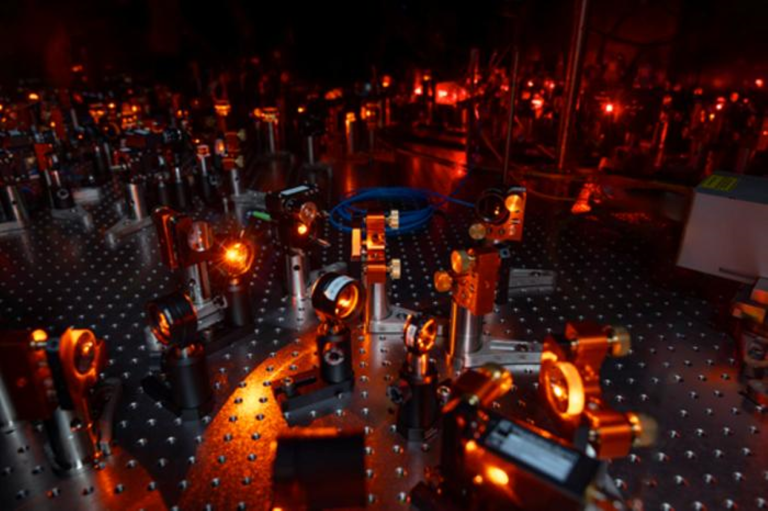Physicists Enter 'New Frontier' for Quantum Computing
The discovery may lead to more robust quantum computing and support new research techniques.
The two separate studies center on the process of quantum entanglement—a bizarre phenomenon that allows two particles to stay intimately linked together despite being separated across vast distances. It is a process described by Albert Einstein as "spooky action at a distance" and occurs when two particles exist in a superposition between two or more different states.
"A conventional classical computer implements logical operations on binary data, memory comprised of units called bits which can be either 0 or 1," Stephen Clark, an associate professor of physics at the U.K.'s University of Bristol who was not involved in the study, told Newsweek.
"In contrast, a quantum computer is a device that leverages a key feature of quantum mechanics called superposition...which is equally 0 and 1 at the same time," he said.
To understand how this property supports quantum computing, Clark compared it to the geography of our planet.
DeepMind AI Breakthrough Could Revolutionize Battery and Chip Development
1:30
"You can visualize this as 0 and 1 being the North and South Pole and a [superposition state] being on the equator. So while a classical bit can only ever be at the poles, a [quantum bit, called a qubit] can explore the entire surface of a sphere."
To be useful, a quantum computer must comprise many thousands of qubits. "Once you have many qubits, the principle of superposition gives rise to the most fundamental and useful features of quantum mechanics—entanglement," Clark said.
Despite being separated across the computer chip, these qubits remain in their state of superposition, where both members of the pair could equal 0 and 1 at the same time.
"Roughly speaking, a quantum computer can outperform a classical computer by firstly creating a huge superposition of all possible [and exponentially many] inputs...and then can process each of these like a classical computer in parallel," Clark said. "The state created by doing this generates enormous amounts of entanglement, making it a ubiquitous ingredient of a quantum computer."
However, creating controllable states of entanglement remains a challenge. "Demonstrating verifiable and controllable entanglement in any new technological platforms is a highly nontrivial and important breakthrough," Clark said.
In the past, small particles like photons and ions had been controllably linked in this state.
"What makes these two studies particularly important is that they involve molecules which are relatively large objects," Clark said. "This makes them harder to control but also potentially more powerful for processing."
In a recent issue of the journal Science, two separate studies have demonstrated how states of entanglement can be induced in these larger molecules. A Princeton team led by physics professor Lawrence Cheuk used laser-cooling technologies to slow the molecules down to a state in which quantum behavior was measurable before carefully placing the individual molecules in a precise configuration. To move the molecules, the team used a complex system of focused lasers that act like a pair of super-fine tweezers.

LASER SETUP FOR COOLING, CONTROLLING, AND ENTANGLING INDIVIDUAL MOLECULES. RICHARD SODEN, DEPARTMENT OF PHYSICS, PRINCETON UNIVERSITY© RICHARD SODEN, DEPARTMENT OF PHYSICS, PRINCETON UNIVERSITY
The molecules in question contain the atoms calcium and fluorine. The negative electrons within the molecule lie slightly close to the fluorine, making this end of the molecule slightly negatively charged.
The calcium end, meanwhile, has a slight positive charge. When they are held inside the tweezer array, these molecules can therefore exist in two states—they can exist with the positive charge pointing up or with the positive charge pointing down, just like when you put a battery inside a watch.
By separating these molecules into pairs, this interaction between opposing charges enables the researchers to produce controlled entanglement between the paired molecules.
Similar results were seen by a team at Harvard and MIT.
"Using molecules for quantum science is a new frontier and our demonstration of on-demand entanglement is a key step in demonstrating that molecules can be used as a viable platform for quantum science," Cheuk said in a statement.
He went on: "The fact that [the Harvard and MIT team] got the same results [verifies] the reliability of our results. They also show that molecular tweezer arrays are becoming an exciting new platform for quantum science."
As well as potential future applications in quantum computing, these results may also support physics research at a more fundamental level, according to Clark.
"For example, it could allow laser cooling techniques—which work very well for atoms—to be applied to larger, more complex molecules," he said. "Creating entangled states of more massive objects like molecules could also be useful for doing quantum-enhanced precision measurement on gravity, as well as exploring how entanglement can alter collisions and chemical reactions between molecules. These are likely to have a more immediate impact in science."
Cheuk said the results are "also a breakthrough for practical applications because entangled molecules can be the building blocks for many future applications."
No comments:
Post a Comment